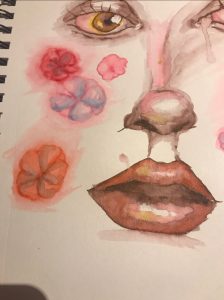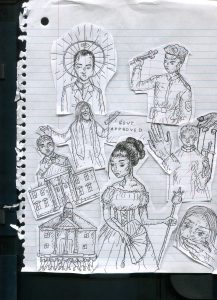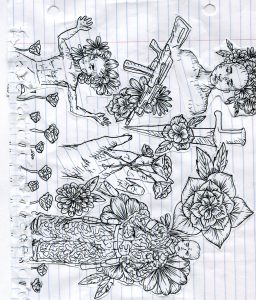For my fourth round of meditative/analytical art, I felt inspired to completely switch up the medium and artistic style of my work. Previously I have stuck with creating a series of gel pen sketches that are all connected by similar themes, then compiling them into a collage. However, I wanted to challenge myself this time to create one piece/a singular image that encompasses all of my ideas. I decided to switch to watercolor, which is a particularly challenging medium but whose flow I thought would be very conducive to the meditative aspect of this project. Comparing the two, I found that the sketch collages allowed me to easily follow and convey a flow of consciousness because sketching comes easily to me. However, this watercolor made me spend much more time analyzing exactly how to convey my thoughts into a single image. For this watercolor I found myself still focusing on Jean Zaru’s Occupied With Nonviolence. I spent a lot of time focusing on the anatomy and shading of the lips on this piece, as Zaru seems to speak her personal truth very directly, and the authority she has over her own speech is her main source of power. In many of my previous collages, flowers showed up as a common theme to symbolize unity and life amidst chaos and violence. In this, the flowers on Zaru’s face were meant to show how the struggles she has faced in her life may have left scars, but it is from this that she draws beauty and empowerment. Her empathy and understanding of the human condition as informed by her religion are very beautiful qualities to me, and I see these qualities in the flowers that adorn her. However, I did not want to downplay the trauma that her involvement in this conflict has caused her, so I painted bloodshot and teary eyes. This was by far the most enjoyable artistic practice for me, so I plan on using watercolors again in my next round.
Author: Abigail Cooper-Drake
As with my last sketch collage, I focused on Kurlansky’s Nonviolence : The History of a Dangerous Idea as my source of creative inspiration. Looking back on my last discussion, I noticed that the practice did not feel as meditative as my original collage, most likely because I had not set specific parameters for my focus and allowed myself to narrow in on some of Kurlansky’s points that I found personally conflicting or troubling. In order to redirect my focus, I decided to choose more specific inspiration for this practice – I chose my top six favorite rules/observations of nonviolence that Kurlansky lists in the appendix:
- The problem lies not in the nature of man, but in the nature of power
- Despite all of society’s promotion of warfare, most soldiers find warfare to be a wrenching departure from their own moral values.
- The state imagines it is impotent without without a military because it cannot conceive of power without force.
- Violence does not resolve. It always leads to more violence.
- A propaganda machine promoting hatred always has a war waiting in the wings.
- Behind every war there are always a few founding lies.
Below are my artistic reflections of these observations. These sketches ended up being much more crude and cartoonish than my others, most likely because I spent much more time analyzing the meaning and translating it into art than on actually finessing the details of my work. I found that choosing narrow and specific concepts and forcing myself to convey them through symbolic imagery was very useful in diving deeper into the meaning of each statement. Representing a written idea through art requires utter commitment to your own interpretation of that concept, and I am finding it is a really powerful way to solidify my understanding of texts.

This is the second round of meditative sketch collaging that I have done for my personal project. I decided to spent a little more time focusing on the meditative aspect of this practice, so I made a playlist of calming music and rented out a quiet study room in the library so I could focus all my energy on my art. Surprisingly, this collage came out much less unified than my last one, which was interconnected with a flow of life energy symbolized by the flowers present in nearly every sketch in the collage.
The disunity in this collage is probably due to my personal conflict with the material that I was analyzing. For this collage session, I set my intention to focus on expressing my interpretation of Kurlansky’s Nonviolence: The History of a Dangerous Idea. I noticed I had a very strong reaction to his depiction of Christianity, especially in its history of being manipulated by state powers and being brokered as political leverage. Many of my sketches show typical symbols of institutionalized power controlling images Christianity or censoring/shaping a faith to fit their agenda. This was difficult for me as I am uncomfortable seeing my religion depicted in this way in Kurlansky’s text, but found a release in expressing this discomfort through art and claiming ownership over my own interpretation of his claims. I genuinely do feel more at peace with the text after this particular session.

For my personal project I chose to create a sketch collage reflecting on John Horgan’s The End of War. The title of this collage is The Will of Us All, as it is specifically a reflection on Horgan’s theory that the end of war or the act of nonviolence is a matter of willpower on the part of mankind. In particular, I kept in mind one of Horgan’s most powerful quotes – “Choices, freely made, are what make life meaningful” (Horgan 2014, pg. 187).
I have been practicing stream of consciousness sketching for many years as a way to help battle my anxiety disorder, and I often like to choose a central idea or quote to base my sketch off of. I would consider stream of consciousness sketching a meditative form of art, as the artist is not bound by expectations of a specific product but rather creates for the purpose of self-healing. My personal art almost always involves flowers, as I see them as symbolic of a unifying life force. In this collage, I found myself associating flowers with images of violence, such as soldiers or weapons. I also entwined these flowers with images of protest and resistance, such as a kneeling man or a meditator. The symbols of life and energy flow throughout violence and nonviolence, complacency with the system and resistance against it. Although many of the images in this collage are in great conflict, they are still unified by the life force of the flower – I interpret these flowers as the free will to which Horgan refers. As Horgan suggests, free will is the one tool that unifies all humans, and yet it is also what allows us to so easily divide.
